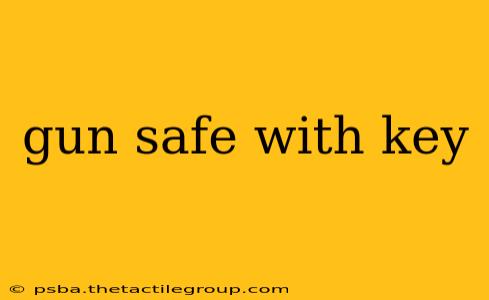Choosing the right gun safe is a crucial decision for responsible gun owners. While electronic locks offer convenience, many prioritize the simplicity and reliability of a gun safe with a key. This guide delves into the advantages, disadvantages, and considerations when selecting a key-operated gun safe, helping you make an informed choice that best protects your firearms and family.
Why Choose a Gun Safe with a Key?
Several compelling reasons exist for choosing a gun safe secured by a key:
-
Reliability: Key-operated safes are less susceptible to power outages or electronic malfunctions. This ensures access to your firearms remains consistent, regardless of unforeseen circumstances. A dead battery won't leave you locked out.
-
Simplicity: Key operation is inherently straightforward. There's no need to remember complex combination codes or deal with potential electronic glitches. This simplicity is particularly valuable in stressful situations.
-
Cost-Effectiveness: Generally, key-operated gun safes are less expensive than their electronic counterparts, making them a budget-friendly option for responsible gun owners.
-
Security Against Hacking: Unlike electronic locks, key-operated safes are immune to hacking attempts or electronic breaches. This offers a significant advantage in terms of security against unauthorized access.
Key Considerations When Choosing a Key Safe:
-
Security Rating: Look for safes with high security ratings, such as those from UL (Underwriters Laboratories), indicating resistance against forced entry and attacks. A higher rating translates to a more robust and secure safe.
-
Fire Resistance: Consider the fire-resistant capabilities of the safe. Fire ratings are expressed in terms of how long the safe can protect its contents from fire damage. Choose a rating appropriate to your needs and the risk of fire in your location.
-
Size and Capacity: Measure the space available and determine the number and size of firearms you need to store. Choose a safe that comfortably accommodates your collection while still offering sufficient security.
-
Key Management: Plan for key management and storage. Store your spare key in a secure, easily accessible, but hidden location, and consider using a waterproof and tamper-evident key safe.
Types of Key Locks:
While most key safes utilize standard keyed locks, there are variations:
-
Double-bitted Key Locks: These offer greater resistance to picking compared to single-bitted locks.
-
High-Security Key Locks: Certain safes incorporate specialized key locks with enhanced pick-resistance mechanisms. These often require specific keyways that aren't easily duplicated.
Maintaining Your Gun Safe with Key:
Regular maintenance is vital for optimal performance and security:
-
Lubrication: Periodically lubricate the lock mechanism to ensure smooth operation and prevent jamming. Use a lubricant specifically designed for locks.
-
Inspection: Regularly inspect the safe's exterior and interior for any signs of damage or wear. Address any issues promptly.
-
Key Care: Protect your keys from damage, keep them separate from other keys, and avoid exposing them to extreme temperatures or moisture.
Conclusion:
A gun safe with a key offers a reliable, simple, and often cost-effective solution for securing firearms. By carefully considering the security rating, fire resistance, size, and key management aspects, you can choose a safe that meets your specific needs and provides peace of mind. Remember, responsible gun ownership includes securing your firearms appropriately; a well-chosen gun safe with a key is a crucial component of this responsibility.

